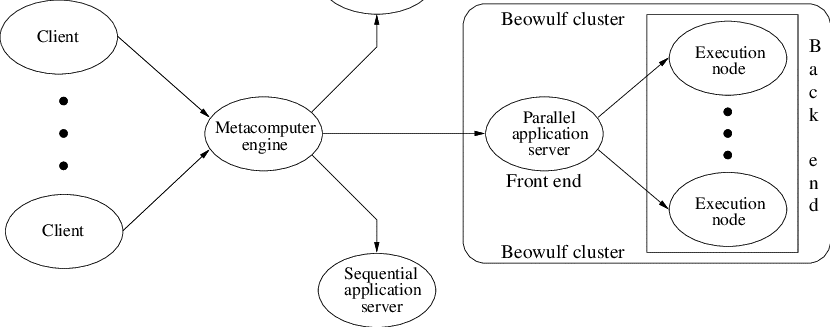Request a supercomputer!

The Supercomputer Center at Imam Khomeini International University
The Supercomputer Center at Imam Khomeini International University has been developed to find solutions for ultra-advanced computational problems. A supercomputer is a concept where multiple computers share their processing power to perform a computational task. Simulators from Amirkabir have equipped this center by renting out advanced equipment and computers. This article aims to provide information about the center and its various sections, such as the cloud computing center of Imam Khomeini International University.
← Rent a Supercomputer →
The first phase of creating a meta-computer involves developing and using software to simplify the user’s task of utilizing various computational elements. For each project, an average user may use a desktop workstation, a remote supercomputer, a central processing unit supporting massive storage archives, and a specialized graphics computer. This phase was thoroughly considered in the construction of the Supercomputer Center at Imam Khomeini International University.
Some users in the past decade have worked in this environment and used ad hoc and customized solutions to provide specific capabilities optimally. In most cases, data and program transfers were manually conducted from one machine to another. The Supercomputer Center at Imam Khomeini International University has also made significant progress in this regard.
The primary goal of building a meta-computer is to eliminate the difficulties of executing projects within such a diverse array of computer systems. This first phase is primarily a software and hardware effort that involves connecting all resources with high-performance networks, implementing a distributed file system, coordinating user access across various computational elements, and creating a seamless environment using existing technology. This phase is well underway at the Supercomputer Center of Imam Khomeini International University.
The next phase in developing the supercomputer at Imam Khomeini International University involves the software integration of a heterogeneous computer network. This second phase includes distributing a single program across multiple computers, allowing the heterogeneous systems at the center to work collectively on a single problem. This enables users to perform computational tasks that would otherwise be nearly impossible without a meta-computer.
The software enabling the complete functionality of the rapid processing center at Imam Khomeini International University (as opposed to temporary or one-time solutions) is newly emerging and is currently in the evaluation and improvement stages as users begin working with it. Additionally, considering the high costs of equipment, Amirkabir Simulators suggest renting the parallel and rapid processing systems of Imam Khomeini International University.
← Rent a Supercomputer →
In explaining the implementation of the Supercomputer Center at Imam Khomeini International University, it should be noted that the evolution of meta-computing capabilities is limited not only by software but also by network infrastructure. At any given point, the capabilities of a local meta-computer are approximately 12 months ahead of those available on a larger scale. This is primarily due to the difference in capacity between a Local Area Network (LAN) and a Wide Area Network (WAN). While individual capabilities change over time, the gap between LAN and WAN capabilities remains consistent. It should be noted that the rapid computing center at Imam Khomeini International University has also grown significantly.
The third phase in the evolution of meta-computers will involve creating a national transparent network that significantly increases the computational and informational resources available to a program. This phase goes beyond using remote resources (i.e., bridging distances between components) by the local meta-computer.
The third phase of the High-Performance Computing (HPC) system at Imam Khomeini International University includes establishing a suitable WAN infrastructure and developing standards for administrative, file system, security, accounting, and other levels to allow multiple LAN supercomputers to collaborate. Significant progress has been made in this phase at the Supercomputer Center of Imam Khomeini International University.
The initial step towards this goal involves collaboration between four National Science Foundation (NSF) supercomputer centers to create a “National Virtual Machine Room.” Eventually, this effort will evolve into a truly national initiative encompassing all systems within the National Research and Education Network (NREN). System software must evolve to transparently identify resources and distribute tasks efficiently. The parallel processing and networking laboratory at Imam Khomeini International University has also been developed with assistance from Amirkabir Simulators.

The Supercomputer Center at Imam Khomeini International University performs advanced computations at relatively high speeds and at a lower cost compared to other computers and processors. Since purchasing equipment is costly, Amirkabir Simulators have offered advanced computers and necessary equipment for rent while also providing practical and valuable consultations. It must be stated that the computational server at Imam Khomeini International University, which is advancing and developing, owes much of its progress to the support provided by this organization.
What is metadata on a website?
Simply put, metadata describes other data. Website metadata includes the page title and meta descriptions for each page.
What are the four types of computer networks?
A computer network primarily has four types:
What is programming in computers?
Computer programming is the process used by professionals to write code that instructs a computer or software program on how to function. At its most basic level, computer programming is a set of instructions designed to facilitate specific actions.
Related links